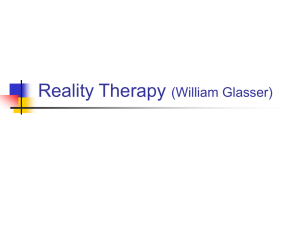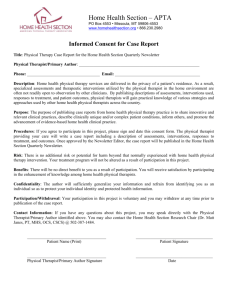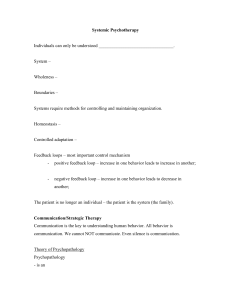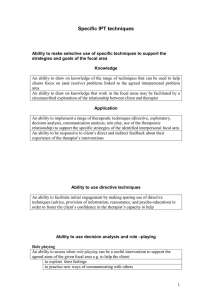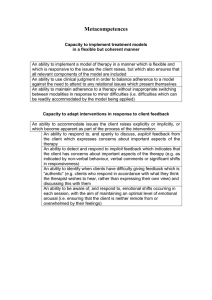Theory and Practice of Counseling and Psychotherapy Psych422 Chapter11: Reality Therapy
advertisement
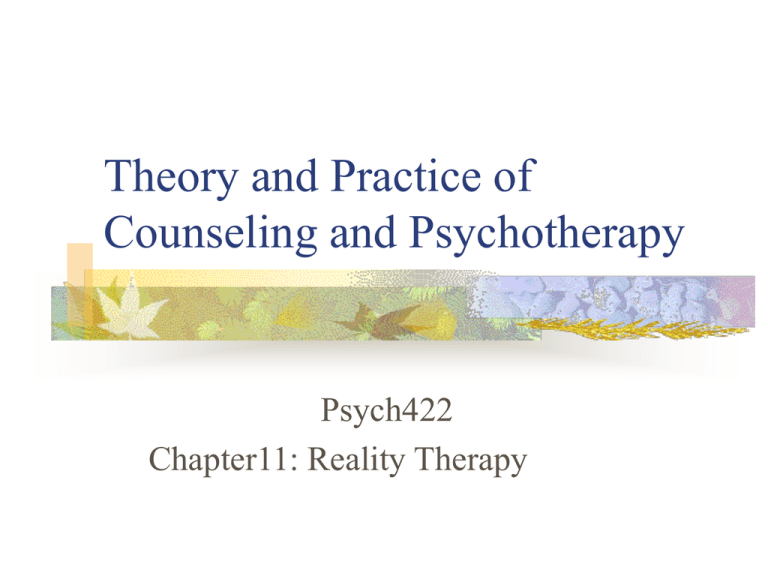
Theory and Practice of Counseling and Psychotherapy Psych422 Chapter11: Reality Therapy Reality Therapy Basic Beliefs Focus on responsibility to choice keep therapy focused on the present Focus on the unsatisfying relationship or the lack of connection, which is often the cause of problems The only person you can control is yourself Behavior = our attempt to get what we want Focusing symptoms is protect clients from facing the reality of unsatisfying present relationships View of Human Nature All internally motivated behavior is geared toward meeting our basic human needs Belonging and love Power or achievement Freedom or independence Fun or enjoyment Survival (Physiological needs) Our brain functions as a control system to get us what we want View of Human Nature Teach clients choice theory so clients can identify the frustrated need and try to satisfy it. Quality world: we store experiences of how we can fulfill our basic psychological needs in our brain. From the relationship with the therapist, client learn how to get close to the people they need Therapeutic Goals Help clients get connected or reconnected with the people they have chosen to put in their quality world Help clients learn better ways of fulfilling all of their needs Therapist’s function and Role Create a good relationship with their clients Challenge clients to evaluate themselves Are your behaviors getting you what you want and need? Instill a sense of hope Therapist is someone who is on the client’s side Client’s Experience in Therapy Clients are not expected to go back to talk about the past or symptoms Therapists often ask clients questions to challenge them to evaluate themselves “Is what your are choosing to do bringing you close to the people you want to be closer to? Relationship Between Therapist and Client Emphasize an understanding and supportive relationship by warmth, caring, concern, acceptance… Both involvement with and concern for the client are demonstrated throughout the entire process Once relationship is established, therapists challenge the reality and consequences of their actions Continually assist clients to evaluate the effectiveness of their behavior Therapy is a mentoring process with therapist as a teacher and client is a student. Therapeutic techniques and procedures Establishing a supportive relationship Exploring clients’ needs, wants, and perceptions Evaluating how effective they are in getting what they want Realizing they can control only their own behavior Procedures That Lead to Change: The “WDEP” System W Wants - What do you want to be and do? D Doing and Direction - What are you doing? E Evaluation - Does your present behavior have a reasonable chance of getting you what you want? P Planning – identify ways to fulfill their wants and needs. ****Apply WDEP to your life experiences? Planning For Change SAMIC S Simple - Easy to understand, specific and concrete A Attainable - Within the capacities and motivation of the client M Measurable -Are the changes observable and helpful? I Immediate and Involved - What can be done today? What can you do? C Controlled - Can you do this by yourself or will you be dependent on others? From a multicultural perspective Contributions Focus on acting and thinkingless likely to display resistance to counseling Relationships are the problem in all cultures Allow for a wide range of acceptable behaviors to satisfy these needs Limitations Ignoring environmental factor may let clients feel misunderstood Some cultural values---not values to be assertive to ask what they need instead of thinking more of what is good for the social group. Summary and Evaluation Contributions Insight and awareness are not enough; the client’s self-evaluation, a plan of action, and a commitment to following through are the core of the therapeutic process. Accepting personal responsibility Gaining more effective control Focusing on what they can do in the present to change their behavior Summary and Evaluation Limitations Not give enough emphasis to feelings, unconscious, dream, transference, the effect of early childhood experiences, and the power of the past to influence one’s present personality.
